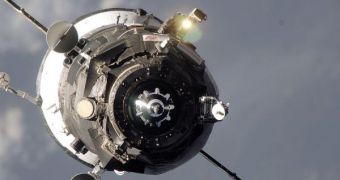The weeks of commotion aboard the International Space Station (ISS) just keep on coming. After a crew change, the arrival of the Soyuz TMA-16 capsule, the departure of the TMA-14 capsule, the arrival of a new, unmanned Japanese spacecraft, the list of activities was made even bigger, when the Progress 35P space capsule docked to the station on Saturday night. The unmanned cargo freighter is the 35th such mission flown to the orbital outpost in more than ten years, Space reports.
Even though they are not exactly spectacular, these flights, which see the Progress capsules docking themselves to the ISS, are what keeps the station going, providing priceless supplies, such as water, food, scientific equipment, and spare parts. They provide continuous coverage of the ISS' needs, and it's only now that they will begin to “lighten up” on their efforts, The European Space Agency (ESA) has developed its own means of transporting supplies to the ISS, the Automated Transfer Vehicle (ATV), and the Japanese space agency, JAXA, is following suit with the HTV.
The Progress 35 spacecraft docked to the station at 9:40 pm EDT (2340 GMT), as the two spacecraft were flying about 225 miles above the coastlines of Uruguay. “Congratulations on the successful docking,” the crew of the station was told by the Mission Control. There are six astronauts aboard the ISS at this point. Expedition 21 is led by ESA astronaut Frank de Winne. Other astronauts include cosmonauts Roman Romanenko and Maxim Suraev (RosCosmos), and astronauts Jeff Williams and Nicole Stott (NASA), alongside Canadian Space Agency (CSA) flier Robert Thirsk.
According to the flight manifest, the cargo craft carried about 1,750 pounds of solid cargo, including spare parts, scientific equipment and food. Some 926 pounds of water were also loaded on the craft. The refueling module aboard Progress 35 carried 1,918 pounds of propellant, which will be fed to the station's tanks, in the Russian segment of the orbital facility. This fuel is used to power up the thrusters on the station, which allow the crew to maneuver the entire complex in and out of orbit, so as to avoid dangerous space junk.

 14 DAY TRIAL //
14 DAY TRIAL //